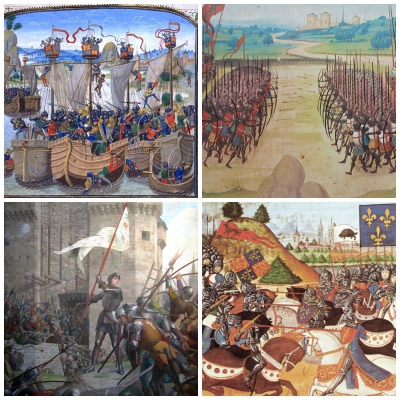The Battle of Verneuil was a battle of the Hundred Years' War, fought on 17 August 1424 near Verneuil-sur-Avre in Normandy between an English army and a combined Franco-Scottish force, augmented by Milanese heavy cavalry. The battle was a significant English victory, and was described by them as a second Agincourt.
The battle started with a short archery exchange between English longbowmen and Scottish archers, after which the force of 2,000 Milanese heavy cavalry charged the English, brushed aside an ineffective English arrow barrage and wooden archer's stakes, penetrated the formation of English men-at-arms and routed one wing of their longbowmen. The Milanese pursued the fleeing English off the field and went on to capture and loot the English baggage train. Meanwhile, the well-armoured English and Franco-Scottish men-at-arms clashed on foot in a ferocious hand-to-hand melee that went on for about 45 minutes. Many of the English longbowmen rallied and joined the struggle. The French and Scottish men-at-arms broke in the end and were slaughtered, with the Scots in particular receiving no quarter from the English. The Milanese cavalry returned to the field at the end of the battle but fled upon discovering the fate of the Franco-Scottish force.
Altogether some 6,000 French and Scottish were killed and 200 taken prisoner. The Burgundian chronicler Jean de Wavrin, who fought in the battle, estimated 1,600 English killed, although the English commander, John, Duke of Bedford, claimed to have lost only two men-at-arms and "a very few archers". The Scots army, led by the earls of Douglas and Buchan (both of whom were killed in the battle), was almost destroyed. Many French nobles were taken prisoner, among them the Duke of Alenon and the Marshal de La Fayette. After Verneuil, the English were able to consolidate their position in Normandy. The Army of Scotland as a distinct unit ceased to play a significant part in the Hundred Years' War, although many Scots remained in French service.
The Hundred Years' War (French: La guerre de Cent Ans; Picard: Dgère d'Un Chint Ans; 1337–1453) was a series of armed conflicts between the kingdoms of England and France during the Late Middle Ages. It originated from disputed claims to the French throne between the English royal House of Plantagenet and the French royal House of Valois. Over time, the war grew into a broader power struggle involving factions from across Western Europe, fueled by emerging nationalism on both sides.
The Hundred Years' War was one of the most significant conflicts of the Middle Ages. For 116 years, interrupted by several truces, five generations of kings from two rival dynasties fought for the throne of the largest kingdom in Western Europe. The war's effect on European history was lasting. Both sides produced innovations in military technology and tactics, including professional standing armies and artillery, that permanently changed warfare in Europe; chivalry, which had reached its height during the conflict, subsequently declined. Stronger national identities took root in both countries, which became more centralised and gradually rose as global powers.The term "Hundred Years' War" was adopted by later historians as a historiographical periodisation to encompass related conflicts, constructing the longest military conflict in European history. The war is commonly divided into three phases separated by truces: the Edwardian War (1337–1360), the Caroline War (1369–1389), and the Lancastrian War (1415–1453). Each side drew many allies into the conflict, with English forces initially prevailing; the House of Valois ultimately retained control over France, with the previously-intertwined French and English monarchies thereafter remaining separate.

 English
English  español
español  français
français  português
português  русский
русский  العربية
العربية  简体中文
简体中文 
